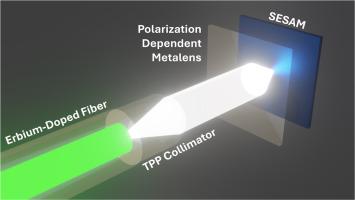基于金属透镜的GHz光纤锁模激光器系统建模
IF 3.7
2区 工程技术
Q2 OPTICS
引用次数: 0
摘要
基于光纤的无源锁模激光器(mls)是一种成熟的高速光通信技术,能够产生具有高能量的超短脉冲。虽然大多数商用mls工作在100 MHz左右的重复频率,但将该频率增加到GHz范围会带来重大挑战,包括极化控制、可饱和吸收器的有效饱和、散热和实现高自由频谱范围(FSR)。为了解决这些限制,我们提出了一个由超透镜和3d打印光纤尖端准直器组成的系统。超构透镜的设计是在分散正交分量的同时选择性聚焦一个偏振,从而解决偏振控制问题。为了提高其性能,增加对位置偏移和角度倾斜的容错,我们利用双光子聚合(TPP)制造了一种光纤尖端准直器。我们的模型表明,该集成系统可以在控制极化的同时实现基于光纤的mls的小型化,通过更好的散热提高可饱和吸收器的效率,并以更短的光纤长度提高FSR。本文章由计算机程序翻译,如有差异,请以英文原文为准。

Modeling a metalens-based system for GHz fiber mode-locked lasers
Fiber-based passive mode-locked lasers (MLLs) are a well-established technology for high-speed optical communications, capable of generating ultrashort pulses with high energy. While most commercial MLLs operate at repetition rates around 100 MHz, increasing this frequency to the GHz range introduces significant challenges, including polarization control, efficient saturation of the saturable absorber, heat dissipation and the achievement of a high free spectral range (FSR). To address these limitations, we propose a system consisting of a metalens and a 3D-printed fiber-tip collimator. The metalens is designed to selectively focus one polarization while diverging the orthogonal component, thereby addressing the polarization control. To enhance its performance and increase tolerance to positional offsets and angular tilts, we fabricated a fiber-tip collimator using two-photon polymerization (TPP). Our model suggests that this integrated system could enable the miniaturization of fiber-based MLLs while controlling polarization, enhancing the efficiency of the saturable absorber through better heat dissipation, and increasing the FSR with a shorter fiber length.
求助全文
通过发布文献求助,成功后即可免费获取论文全文。
去求助
来源期刊

Optics and Lasers in Engineering
工程技术-光学
CiteScore
8.90
自引率
8.70%
发文量
384
审稿时长
42 days
期刊介绍:
Optics and Lasers in Engineering aims at providing an international forum for the interchange of information on the development of optical techniques and laser technology in engineering. Emphasis is placed on contributions targeted at the practical use of methods and devices, the development and enhancement of solutions and new theoretical concepts for experimental methods.
Optics and Lasers in Engineering reflects the main areas in which optical methods are being used and developed for an engineering environment. Manuscripts should offer clear evidence of novelty and significance. Papers focusing on parameter optimization or computational issues are not suitable. Similarly, papers focussed on an application rather than the optical method fall outside the journal''s scope. The scope of the journal is defined to include the following:
-Optical Metrology-
Optical Methods for 3D visualization and virtual engineering-
Optical Techniques for Microsystems-
Imaging, Microscopy and Adaptive Optics-
Computational Imaging-
Laser methods in manufacturing-
Integrated optical and photonic sensors-
Optics and Photonics in Life Science-
Hyperspectral and spectroscopic methods-
Infrared and Terahertz techniques
 求助内容:
求助内容: 应助结果提醒方式:
应助结果提醒方式:


